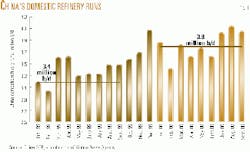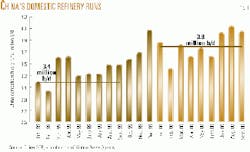China's crude imports disrupt global supply
China's healthy economy in 2000 triggered a "seemingly insatiable demand" for crude oil, causing demand to grow 9% year-over-year.
As a result, China's crude imports increased more than 700,000 b/d, implying a crude oil inventory build of 260,000 b/d, or 71 million bbl, the first 9 months of 2000. This build in China's oil inventory, coupled with an improved refinery utilization rate, may explain the so-called "missing" barrels phenomenon currently plaguing global oil demand and supply analysis, according to a report by Credit Suisse First Boston Corp. (CSFB).
The analyst noted, "These missing barrels are the difference between calculated demand and supply numbers and reported inventory move. Whatever the truth behind China's actual domestic consumption growth, the effect of China on the crude markets [in 2000] has more to do with the huge increase of over 700,000 b/d in the country's net crude oil imports. This rise is being driven by the large rise in domestic refinery utilization rates and the associated inventory build, which to us seems rather larger than should be necessary."
Crude imports
CSFB said that much of the dislocations between supply, demand, and price in 2000 were attributable to abnormal crude trading patterns by China's refining industry.
The analyst noted that most of the extra Organization of Petroleum Exporting Countries crude were routed to the Far East rather than Europe or the US. Japan and China were the main recipients of OPEC crude, with Japan receiving 5.5 million b/d and China 4.5 million b/d. But unlike China, Japan's crude imports were down 40,000 b/d the first 9 months of 2000.
"It has been apparent for some time that the extra oil being produced by OPEC is not finding its way to US and European inventory tanks. This reduction in western (i.e., visible) inventory has caused a rise in the supply disruption risk premium at the front of the crude oil futures curve, raising the spot price and helping to maintain the backwardated market," CSFB said.
China's refining system
China's dramatic demand increase last year has also been linked to significant change in its refining runs and import-export patterns. PetroChina Co. Ltd. and Sinopec, which control nearly all of China's domestic refining capacity, boosted their refining output to maximize profitability and follow the plans set out for the companies' privatizations.
In 2000, China's refining output grew by 440,000 b/d from 1999, a utilization rate increase to 80% from 65% (Fig. 1).
CSFB reported that China plans "only modest increases" in domestic refinery runs this year, which suggests that the strong demand pull China exerted on the global crude oil market in 2000 is not likely to be repeated.
New construction has and will continue to be partially offset by the closure of smaller, less efficient, and sometimes unreported plants, said the company. Most of the new investments in China's refining system will be made in secondary processing units to meet tougher new fuel specifications and not to raise overall refining capacity.
The investment in secondary units should increase China's ability to process heavier and more-sour crudes. China's refining system is configured to process domestic crudes, which are generally lighter and sweeter than OPEC's recent incremental output.
"The effect of this nonoptimal configuration for crude input during a time of rising utilization has been a large increase in China's imports of low-sulfur crude and an unusual level of support for sweeter global crude price markers, principally WTI and Brent. Cargoes of North Sea Brent oil have even been spotted turning up in China, an unusual event indeed," said CSFB.
Asia-Pacific oil demand
Asia, like many countries, experienced radical swings in oil demand growth rates last year as a result of high oil prices. A prime example of this is India, which had a total oil demand growth of 0.2% as of November 2000 vs. a 9.4% growth in 1999.
In 2001, oil demand in Asia-Pacific will grow 4.5% (Fig. 2). The analyst predicts that China will not carry the bulk of this year's growth expectation burden for Asia-Pacific, but rather, it will be split evenly among Asia's oil powerhouses-Japan, China, Korea, and India (LPG excluded).
"The problem, then, with forecasting 4% oil demand growth in Asia-Pacific demand for 2001 is that it is highly unlikely to happen at anything like current oil prices," said CSFB. "We would once again caution against using bullish consensus demand growth estimates, which need to be based on a large projected oil price fall, in order to construct a high oil price forecast for 2001. It just doesn't work that way."


